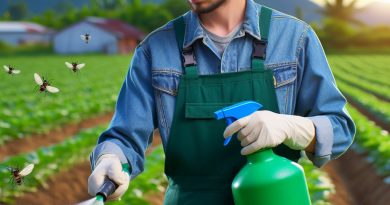Flood-Resilient Farming Practices
Last Updated on March 2, 2024
Introduction
A. Importance of flood-resilient farming practices
Flood-resilient farming practices are crucial for ensuring food security and sustainable agricultural development.
These practices help farmers mitigate the negative impacts of floods on their crops and livestock.
B. Brief overview of flood impacts on agriculture
Floods have devastating effects on agriculture, causing crop damage, soil erosion, and loss of livestock.
They can also lead to waterlogging, which affects plant growth and reduces productivity.
Floods disrupt the entire farming system, leading to food shortages and economic instability.
Implementing flood-resilient farming practices is essential to minimize these impacts, protect farmers’ livelihoods, and ensure food production.
These practices include water management strategies, improved drainage systems, and the use of flood-resistant crop varieties.
Farmers can adopt techniques such as contour plowing, terracing, and building raised beds to prevent soil erosion and waterlogging.
Planting cover crops and maintaining vegetative buffers along water bodies can also help to reduce the impact of floods on crops.
Furthermore, the integration of modern technology, such as remote sensing and weather forecasting, can facilitate early warning systems, enabling farmers to take preventive measures.
Additionally, providing farmers with access to financial resources, insurance, and training on flood-resilient practices is crucial for their adaptation and resilience.
In fact, flood-resilient farming practices play a vital role in protecting agricultural systems from the detrimental impacts of floods.
Implementing these practices is essential for sustainable food production, improved livelihoods, and climate change adaptation in flood-prone areas.
Understanding the Impact of Floods on Farming
A. Major challenges faced by farmers during floods
- Crop loss: Floods can submerge fields, drowning crops and causing significant crop loss for farmers.
- Soil erosion: Heavy rainfall during floods can lead to soil erosion, washing away valuable nutrients required for plant growth.
- Infrastructure damage: Floods can damage farm infrastructure such as barns, storage facilities, and irrigation systems.
B. Economic consequences for farmers
Floods have severe economic implications for farmers, which can impact their livelihoods and overall agricultural production.
- Financial losses: Farmers face substantial financial losses due to crop damage, infrastructure repairs, and the need to replace lost equipment.
- Decreased production: Floods disrupt farming operations, leading to decreased production, lower yields, and potential food shortages.
- Income instability: Unpredictable weather patterns caused by floods can result in income instability for farmers, affecting their ability to sustain their families.
- Increase in production costs: Floods often result in increased production costs as farmers need to invest in flood-resistant farming techniques and infrastructure.
- Market fluctuations: Floods can disrupt local and regional markets, leading to price fluctuations, reduced demand, and difficulty in selling farm produce.
In short, floods have a significant impact on farming, posing major challenges for farmers and causing economic consequences.
Crop loss, soil erosion, and infrastructure damage are some of the primary challenges faced by farmers during floods.
These challenges, coupled with financial losses, decreased production, income instability, increased production costs, and market fluctuations, contribute to the overall negative effects of floods on farmers.
Implementing flood-resilient farming practices is crucial to mitigate these impacts and ensure the sustainability of agricultural systems in flood-prone areas.
Read: Organic Fertilizers: Boosting Soil Health
Implementing Flood-Resilient Farming Practices
Farmers around the world face numerous challenges when it comes to climate change and extreme weather events.
One of the biggest concerns for farmers is flooding, which can have devastating impacts on crop productivity.
However, by implementing flood-resilient farming practices, farmers can minimize the damage caused by floods and ensure a more stable and sustainable agricultural system.
A. Crop selection and diversification strategies
Crop selection and diversification strategies play a vital role in building flood resilience.
Firstly, choosing flood-tolerant crops that can withstand excess moisture is crucial.
These crops have the ability to survive floods and recover quickly once the water recedes.
Secondly, utilizing cover crops helps improve soil structure, prevent erosion, and retain water, reducing the impact of flooding on crops.
Lastly, rotating crops can minimize the risk of flood-related diseases and pests, as different crops have different vulnerabilities.
B. Soil management techniques
Effective soil management techniques are essential for flood-resilient farming.
Implementing soil erosion control measures, such as contour plowing and the construction of terraces, can help prevent soil from being washed away during floods.
By improving soil structure and fertility through practices like organic matter addition and nutrient management, farmers can enhance water absorption and drainage capacities of their fields.
Conservation tillage methods, such as no-till or reduced tillage, are also important to maintain soil health and prevent erosion caused by heavy rains.
C. Implementing proper drainage systems
Proper drainage systems are crucial to mitigate the effects of flooding.
Constructing terraces and contour plowing on sloping fields can help slow down the flow of water, allowing it to infiltrate the soil rather than causing erosion and runoff.
Installing drainage tiles can improve soil drainage, preventing waterlogging and maintaining optimal soil moisture levels.
Additionally, creating on-farm water management systems, such as ponds or reservoirs, can help capture excess water during heavy rainfall events and release it gradually, minimizing the risk of floods.
By implementing these flood-resilient farming practices, farmers can protect their crops and livelihoods from the adverse effects of flooding.
Moreover, these practices contribute to sustainable agriculture by reducing soil erosion, preserving soil fertility, and conserving water resources.
Government support and financial incentives can encourage farmers to adopt these practices and increase their resilience to climate change.
Additionally, knowledge sharing and education programs play a vital role in ensuring widespread adoption of flood-resilient farming practices.
In general, implementing flood-resilient farming practices is crucial for farmers worldwide to adapt to the challenges posed by climate change.
Crop selection and diversification, soil management techniques, and proper drainage systems are key components of a comprehensive flood resilience strategy.
By adopting these practices, farmers can minimize the impact of floods on their crops, enhance soil health, and build a more sustainable and resilient agricultural system for the future.
Read: Best Soil Types for Growing Wheat: An Overview
Making Investments in Flood-Resistant Infrastructure
Investing in flood-resistant infrastructure is an essential step towards ensuring the resilience of farming practices.
Floods can cause significant damage to agricultural properties, leading to severe financial losses and disruptions to food production.
Therefore, adopting measures to reinforce farm structures, buildings, and equipment becomes essential to minimize the impact of floods.
A. Reinforcing farm structures and buildings
When it comes to protecting farm structures and buildings from floods, choosing flood-resistant materials is of utmost importance.
Opting for materials that can withstand water exposure without deteriorating or becoming weakened can ensure the structural integrity of the infrastructure.
In addition to selecting suitable materials, elevating critical facilities is another crucial aspect of flood resilience.
Raising storage areas, livestock shelters, and other essential structures above the potential flood level can prevent damage and protect valuable assets.
This practice not only safeguards the physical structures but also helps to maintain the safety and welfare of the livestock and crops on the farm.
Implementing proper drainage systems around buildings is equally important.
Ensuring that water can flow away from the structures and doesn’t accumulate near the foundations of buildings is necessary to prevent long-term damage.
Properly designed drainage systems can effectively channel water away from the farm infrastructure, reducing the risk of flooding-induced structural problems.
B. Installing flood-resistant equipment
Apart from reinforcing farm structures, investing in flood-resistant equipment is also crucial in building flood resilience.
Using machinery and tools specifically designed to be flood-proof can help in minimizing damage and keeping agricultural operations operational even during flooding events.
Such equipment is manufactured to withstand water exposure without significant deterioration in performance, allowing farmers to continue their work in challenging conditions.
Protecting electronic equipment and data is another aspect that farmers should consider.
Sensitive electronic devices, such as computers and farm management systems, can be easily damaged by water.
Ensuring these devices are adequately protected or moved to higher ground during flood events is important to safeguard critical information and maintain efficient farm management processes.
In review, making investments in flood-resistant infrastructure is an essential step towards ensuring the resilience of farming practices.
Reinforcing farm structures and buildings with flood-resistant materials, elevating critical facilities, and implementing proper drainage systems are all vital measures to protect agricultural properties.
Additionally, installing flood-resistant equipment and safeguarding electronic devices and data are necessary to maintain productivity even during flood events.
By taking these proactive steps, farmers can better mitigate the risks posed by floods and protect their livelihoods.
Read: Pest Control in Corn Fields: Effective Strategies

Government Support and Resources for Flood-Resilient Farming
A. Federal and state programs
1. Grants and subsidies for implementing flood-resistant practices
These programs offer financial incentives to farmers who adopt flood-resilient practices such as raised beds, conservation tillage, and diversification of crops.
By providing grants and subsidies, the government aims to alleviate the financial burden associated with implementing these techniques.
Implementing flood-resistant practices requires significant investment, and grants and subsidies help farmers overcome this barrier.
The funds can be used to purchase necessary equipment, modify existing infrastructure, or invest in technological solutions.
This support ensures that farmers have the financial means to incorporate flood resilience into their farming operations.
2. Government-sponsored insurance programs
Floods can cause substantial damage to crops, livestock, and property, resulting in significant economic losses for farmers.
Recognizing this, the government has introduced insurance programs specifically tailored to cover losses due to flooding events.
These insurance programs provide a safety net for farmers, giving them the confidence to invest in flood-resilient practices without fearing substantial financial losses in the event of a flood.
By offering coverage for crop damage, infrastructure loss, and other flood-related impacts, these programs contribute to the overall resilience of the farming sector.
B. Extension services and agricultural agencies
1. Providing education and training on flood-resilient farming:
Acknowledging the importance of knowledge and skill-building, extension services and agricultural agencies play a crucial role in educating and training farmers on flood-resilient farming practices.
These organizations offer workshops, seminars, and training sessions on various techniques such as flood-resistant crop selection, soil management, water conservation, and farm drainage systems.
By disseminating best practices and up-to-date information, they empower farmers to make informed decisions and implement effective flood-resilient strategies.
2. Offering technical assistance and resources
Extension services and agricultural agencies also provide farmers with technical assistance and necessary resources to implement flood-resilient practices.
Experts in these organizations assist farmers in designing and implementing tailored flood-resilient solutions according to their specific farm characteristics and needs.
They offer guidance on measures like construction of flood-resistant infrastructure, installation of drainage systems, and implementation of erosion control techniques.
Additionally, they connect farmers with essential resources such as flood-resistant seeds, tools, and equipment.
Basically, government support and resources are vital in promoting flood-resilient farming practices.
Through grants, subsidies, insurance programs, education, and technical assistance, the government plays a proactive role in ensuring the resilience of the agricultural sector in the face of floods and other extreme weather events.
Read: Tomato Cultivation: Tips for a Healthy Crop
Case Studies and Success Stories
A. Farms implementing flood-resilient practices
- Smith Family Farm: The Smith Family Farm in XYZ County implemented flood-resilient farming practices to combat the recurring flood incidents.
- Green Acres Organic Farm: Green Acres Organic Farm in ABC County is a prime example of a farm that successfully integrated flood-resilient practices.
- Johnson Dairy Farm: Johnson Dairy Farm in DEF County transformed their operations to include flood-resilient practices, ensuring their sustainability.
B. The positive outcomes and benefits achieved
- Increased Crop Yield: Farms implementing flood-resilient practices witnessed a significant increase in crop yield due to better water management techniques.
- Reduced Soil Erosion: By adopting flood-resilient farming practices, farms experienced reduced soil erosion, preserving the quality of their land.
- Enhanced Livestock Protection: Flood-resilient practices provided better protection for livestock, minimizing the risk of casualties and promoting animal welfare.
- Improved Water Conservation: Farms using flood-resilient practices effectively conserved water resources, contributing to sustainable agricultural practices.
- Economic Stability: Flood-resilient practices ensure a stable income for farmers by minimizing losses during flood incidents and reducing recovery costs.
- Community Resilience: Farms implementing flood-resilient practices contribute to overall community resilience by maintaining food production during extreme weather events.
In closing, case studies and success stories provide concrete evidence of the benefits and positive outcomes achieved through the implementation of flood-resilient farming practices.
Farms like Smith Family Farm, Green Acres Organic Farm, and Johnson Dairy Farm showcase how these practices can enhance crop yield, reduce soil erosion, protect livestock, conserve water, stabilize the economy, and foster community resilience.
By learning from these examples, more farms can adopt flood-resilient practices to build a more sustainable and resilient agricultural sector.
Find Out More: Chemical Pesticides: Pros and Cons Explained
Conclusion
A. Reinforcing Resilience
Embracing flood-resilient farming is vital.
Employing raised beds, contour plowing, and cover crops combats flood threats effectively.
B. Encouraging Adoption
Farmers, prioritize sustainable practices.
Flood-resistant crops and efficient water management bolster resilience.
Adaptive strategies ensure long-term viability and prosperity.
C. Resources for Progress
Explore further insights. Agricultural extension services and online platforms offer guidance.
References like “Flood-Resilient Farming Handbook” aid implementation. Progress awaits, seize resilience!


